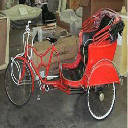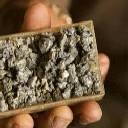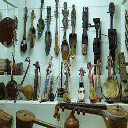Origin of Name of Azamgarh : The district is named after its headquarters town, Azamgarh, which was founded in 1665 by Azam, son of Vikramajit. Vikramajit a descendant of Gautam Rajputs of Mehnagar in pargana Nizamabad, like some of his predecessors, had embraced the faith of Islam. He had a Muhammadan wife who bore him two sons Azam and Azmat. While Azam gave his name to the town of Azamgarh, and the fort, Azmat constructed the fort and settled the bazar of Azmatgarh in pargana Sagri. At the beginning of 18th century, the bulk of the area covered by the present district of Azamgarh was included in the sirkars of Jaunpur and Ghazipur in the subah of Allahabd and was held by the Mohhabat Khan, popularly known as the Raja of Azamgarh. In his time the prosperity of Azamgarh was at its zenith . On September 18,1832 Azamgarh district was formed. The military garrison at Azamgarh in, May 1857 consisted of the 17th Native Infantry, some 500 strong. They were brigaded with the 19th and 34th Regiments at Lucknow. After the struggle of 1957-58 no major events except the Gaurakshini or the anti-cow slaughter movemnet of 1893 occured in the district till the close of the 19th century. The Khilafat movement started in 1920 by the Indian Muslims to bring pressure upon Britain to change its policy towards turkey, also spread in this district. In August 1920, Mahatma Gandhi launched his famous non-coopeartion movement, and the people of the district took part in it under the leadership of Suryanath Singh. In 1928 when the Simon Commission visited India, demonstrations against it wherealso organized in the district as elsewhere. Black flags were waved and banners with words "GO back Simon" were displayed. Mahatma Gandhi visited Azamgarh on October 3, 1929, where he received a tumultuous ovation and addressed a meeting of about 75,000 persons at Srikrishna Pathsala High School. He was also presented with a purse of about Rs.5000/-. Mahatmagandhi spoke on the uplift of Harijans, prohibition and use of swadeshi (Indian made goods). Nextday he inaugurated the Khadi Vidyalya at Azmatgarh. The visit filled the people of the district with strong national feelings. January 26,1930 , was declared the Independence day by the Indian National Congress and thousands in Azamgarh, as everywhere else in India, repeated the solemn and inspiring pledge, "We believe that it is the inalienable right of the Indian people to have freedom ...........................We believe, therefore, that India must sever the British connection and attained Purana Swaraj (complete independence)". In March 1930 salt satyagrah was started by Mahatmagandhi and his arrest caused a great resentment among the people of the district. The students of the local Wesely High School observed strike and about 50 students of this school were expelled. Other Institutions also closed down and a huge procession were jointly taken out by the students and the people. The response of the people of the Azamgarh to the Civil Disobedience Movement was enthusiastic and wide spread. British goods were boycotted and bonfires were made for foreign clothes and western style clothes. On July 4 1930 Gandhi Day was observed in the district condemning Mahatma Gandhi's arrest by oraganising hartal (closure) and protest meetings. In 1931, no-rent campaign was started in the district. The peasants of the tehsil of Sagari and Ghosi withheld payment of rent to government and distributed anti-government leaflats. The news of arrest of Mahatama Gandhi and Ballabhbhai Patel on January 4,1932 reached Azamgarh the nest day. There was widespread resentment in Azamgarh where hartals were observed and processions taken out. The Government retaliated by imposing section 144 Cr. P.C., issuing the press ordinance, the prevention of Intimidation ordinance, and the unlawful Instigation Ordinance and declared the Congress unlawful. When the Mahatam Gandhi launched the programme of individual satyagrah in 1940 the response of the people was once again enthusiastic and all Congress leaders of any consequence in the district were sent to jail. Azamgarh was in the vanguard of the Quit India Movement. which was started on August 9, 1942. On that day, the district Congress office at Azamgarh, was seized; and several arrest were made, the principal one being that of Sita Ram Ashthana. All this naturally created excitement in the town. During the night between the 11th and 12th August, a twenty foot track of rail was removed from a point near Sarai Mir railway station. The incidence of Tarwa thana (police out-post) had its own importance.On the 14th August a large procession proceeded towards the thana for hoisting the tri-colour flag. The processionists stopped in front of the Tarwa thana. Their leader went to the thanedar and advised him to surrender to the people. Hardly did he arrive at any decision when the people caught hold of the policemen and snached their guns. The thanedar had, therefore, no alternative but to surrender. The people assumed the control of thana but agreed to handover to him the personal pistol of the thanedar at his expressed request, because destruction of personal property was not their aim. In this way the thana came under the possession of the freedom fighters.More than 380 persons of the district were detained in connection with the Quit India Movement and 231 were convicted and awarded various terms of imprisonment. The collective fines imposed and released from the people of the district amounted to Rs.1,03,645. At last, on August 15,1947 the country and with it the district shook of the foreign yoke and achieved the long awaited independence. The district celebrated the independence day in a befitting glee and there was rejoieing in every home. National flag was hosted on the Collectorate building, on almost all private and government buildings and even on residential houses and commercial establishment. Every year the day is celebrated with the same enthusiasm. The nation always venerated those who had participated in the struggle. In 1973 on the occasion of celebration of silver jubilee year of Independence, 472 persons of the district who have taken part in India's freedom struggle or their dependence were favoured with tamra patras(copper plate). Placing on record the services rendered by them or their forbears.


































































